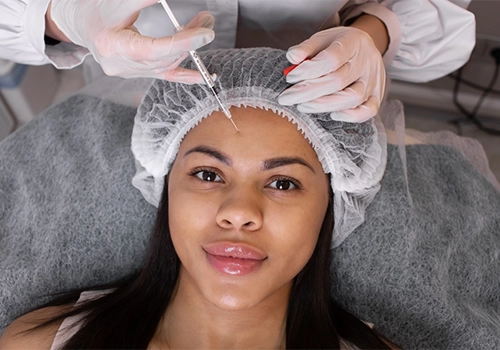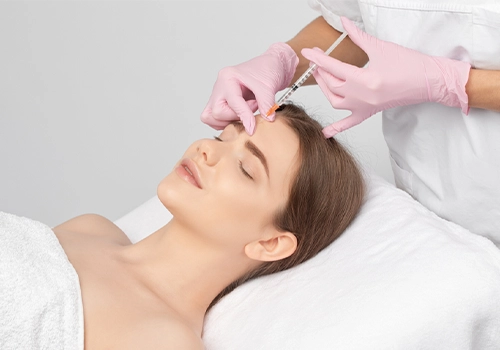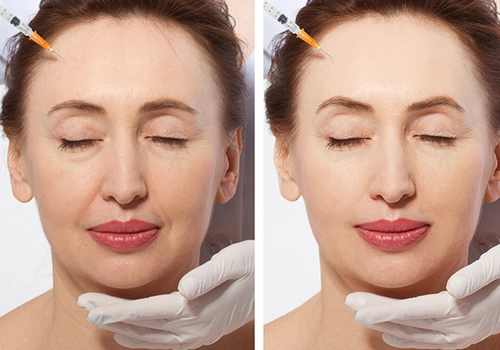Forehead Contouring Procedure
Forehead Contouring, also known as Forehead Reshaping/Remodeling, is a cosmetic surgery procedure designed to enhance the shape and appearance of your forehead. It involves altering the bone structure or soft tissues to achieve a more balanced and harmonious facial profile.
In this article, we’ll explore the world of Forehead Contouring, exploring the different surgical and non-surgical options available. We’ll provide insights into the benefits, risks, and importance of finding a skilled surgeon. If you’re planning to go through this procedure,
” Dr. Maadico’s Cosmetic Department,” is a valuable resource that can help guide you on your journey to achieving the forehead contouring you desire.
What is Forehead Contouring Surgery?
Forehead Contouring is a cosmetic surgery that involves reshaping the forehead to achieve a more balanced and attractive appearance. The procedure can include modifying the bone structure or soft tissues, depending on your specific goals. It’s all about creating a harmonious facial profile that makes you feel confident.
The main goal of Forehead Contouring is to enhance your facial features. This surgery can address issues like a prominent brow bone or a high hairline. It can create a smoother, more balanced forehead, improving overall facial aesthetics.
Candidates for Forehead Contouring
- Prominent Brow Ridge: Forehead Contouring can help those with a pronounced brow ridge achieve a smoother, more balanced forehead by reducing the prominence of the brow bone. This can create a more aesthetically pleasing facial profile.
- High Hairline: Individuals with a high hairline may opt for Forehead Contouring to lower their hairline, creating a more proportional and youthful appearance. This can also make it easier to style their hair.
- Irregular Forehead Shape: Some people have irregularities in their forehead shape that can be a source of dissatisfaction. Forehead Contouring can correct these irregularities, resulting in a more symmetrical and aesthetically pleasing forehead.
- Self-Esteem Concerns: For those who feel that the appearance of their forehead is impacting their self-confidence and overall well-being, Forehead Contouring can be a solution to address these concerns. It can boost self-esteem and improve one’s quality of life.
Benefits of Forehead Contouring
- Improved Facial Harmony: Forehead Contouring can enhance the balance and proportion of your facial features. It helps create a more harmonious appearance, making your entire face look more balanced and aesthetically pleasing.

- Boost in Self-Confidence: When you feel good about your appearance, your self-confidence can soar. Forehead Contouring can address specific aesthetic concerns, and the improved look can boost your overall self-esteem.
- Psychological Effects: Achieving the desired forehead contour can have a positive impact on your mental and emotional well-being. Many individuals experience increased self-assurance, which can enhance their overall quality of life.
Types of Forehead Contouring Procedures
Here are different types of Forehead Contouring Procedures:
Surgical Techniques
- Forehead Reduction Procedure: This surgical procedure focuses on reducing the prominence of the brow bone, creating a smoother and more balanced forehead. It can be an excellent choice for those with a pronounced brow ridge.
- Forehead Augmentation: Forehead augmentation or Cosmetic Forehead Enhancement involves enhancing the forehead’s shape by adding volume or forehead implants. This can be ideal for individuals looking to achieve a more rounded or fuller forehead.
- Hairline Lowering: If you have a high hairline and desire a lower, more proportional hairline, hairline lowering surgery can be the solution. It’s a surgical procedure to lower the hairline, providing a more youthful appearance and improved hair styling options.
Non-Surgical Forehead Contouring
- Dermal Fillers: Dermal fillers are a non-surgical option for forehead contouring. They involve injecting fillers like hyaluronic acid to reshape the forehead and create a smoother appearance. This is a temporary solution and may need periodic touch-ups.
- Botox: Botox injections can relax specific muscles in the forehead, reducing wrinkles and fine lines. While not a permanent solution, Botox can provide a more relaxed and smoother forehead appearance.
Before Surgery
Here are what you should do before the surgery:
Consultation
Choosing a Qualified Surgeon is crucial. Research, read reviews, and seek recommendations. the consultation process is crucial for discussing goals, medical history, and concerns.
Open communication is essential for expressing expectations and understanding achievable outcomes and potential results.

Preoperative Preparation
Here’s some tips for the surgery preparation:
- Follow Your Surgeon’s Instructions: Your surgeon will provide specific guidelines for preoperative preparation, such as dietary restrictions, medication adjustments, and alcohol and smoking cessation.
- Arrange Transportation: Plan for someone to drive you to and from the surgical center on the day of the procedure. Preoperative Health Check: Ensure you’re in good health before the surgery. Your surgeon may require medical tests to confirm your fitness for the procedure.
- Prepare for Recovery: Set up a comfortable recovery space at home with necessary supplies like ice packs, pain medication, and soft foods.
- Avoid Aspirin and Blood Thinners: Stop taking medications that could increase bleeding. Your surgeon will advise you on when to discontinue them.
- Stay Hydrated and Rested: Get ample sleep and stay well-hydrated in the days leading up to the surgery to aid in the recovery process.
- Communicate Any Changes: If you experience any illness or changes in health leading up to the surgery, inform your surgeon immediately.
The Forehead Contouring Procedure
Forehead Contouring surgery is a meticulous process that involves altering the shape of the forehead to achieve your desired appearance. The specific steps will vary depending on your individual goals and the techniques chosen by your surgeon. Some common aspects of the procedure may include:
- Reshaping the brow bone by carefully sculpting it.
- Adding implants or materials to create a fuller or more rounded forehead.
- Adjusting the hairline, if needed, to create a more balanced look.
Anesthesia and Incision Techniques
The type of anesthesia, whether local or general, depends on the complexity of the surgery and your surgeon’s recommendations. Incisions are made with precision to minimize visible scarring. Surgeons often place incisions within the hairline or in natural facial creases to conceal them as much as possible.
Recovery Process and Timeline
After the surgery, you should expect:
Short-Term Recovery
- Immediate Postoperative Period: In the first days after surgery, you can expect some swelling and bruising. Pain and discomfort can be managed with prescribed medications.
- Stitches and Dressings: Your surgeon may remove stitches and change dressings a week or two after surgery, depending on the case.

- Resume Light Activities: You can typically resume light activities within a week, but strenuous exercise should be avoided for a few weeks.
- Swelling Reduction: Swelling and bruising gradually decrease, with most visible improvements in the first few weeks.
Long-Term Recovery
- Full Results Over Months: The final results of Forehead Contouring become increasingly apparent over several months as your facial features settle into their new shape.
- Patience Is Key: It may take up to 6-12 months for the outcome to be fully realized, so patience is essential in the long-term recovery process.
- Follow-up appointments: Regular follow-up appointments with your surgeon are crucial to monitor your progress and address any concerns.
Tips for a Smooth Recovery
- Follow Your Surgeon’s Instructions: Adhere to postoperative guidelines regarding medications, wound care, and activity restrictions for a successful recovery.
- Manage Pain and Discomfort: Take prescribed pain medications as directed, avoiding over-the-counter options unless recommended by the surgeon.
- Use Cold Compresses: Apply cold packs to reduce swelling and bruising, following the surgeon’s recommendations on application methods and timing.
- Maintain Proper Head Elevation: Sleep with your head elevated using extra pillows or a wedge pillow to minimize swelling and enhance comfort.
- Stay Hydrated and Eat Nutritious Foods: Support the healing process with proper nutrition by staying hydrated and consuming a balanced diet rich in vitamins and minerals.
- Avoid Strenuous Activities: Refrain from strenuous exercise or heavy lifting during the initial recovery phase, resuming regular activities based on your surgeon’s advice.
- Protect Your Incisions: Handle incision sites gently, avoiding touching, scratching, or exposing them to direct sunlight to prevent complications and reduce scarring.
Potential Risks and Complications
While Forehead Contouring is generally safe, there are some potential risks to be aware of:
- Infection: Although rare, infections can occur post-surgery. Your surgeon will provide guidelines to reduce this risk.
- Scarring: Incisions may result in minimal scarring, but they are usually discreet. Scarring varies from person to person.

- Nerve Damage: There’s a slight risk of nerve damage, which can affect sensation. Surgeons take precautions to minimize this risk.
Last Word
In this article, we’ve explored the world of Forehead Contouring, a transformative procedure that can enhance your facial harmony, boost self-confidence, and have a positive impact on your well-being.
Choosing the right surgeon and thoroughly researching your options are vital steps in your Forehead Contouring Procedure. We encourage you to explore the possibilities, consult with our experts in Dr. Maadico’s Cosmetic Department, and embark on a path to a more harmonious and confident you through Forehead Contouring.
If you’re ready for a change, request a free consultation.
You may also be interested in knowing about:
Facelift Surgery
Facial Bone Contouring
Chin Reshaping
Double chin Removal
Jawline Surgery
Facial Scar Revision
Dimple Creation
Brow Bone Reduction
Buccal Fat Removal
Facial Feminization
Lip Shaping
Neck Rejuvenation Surgery
Ear Plastic Surgery
FAQs
- Is Forehead Contouring dangerous for pregnant women?
It’s generally not recommended during pregnancy due to anesthesia and healing concerns. Consult with your surgeon, who can provide guidance based on your unique circumstances.
- Why should I take the Forehead Contouring Surgery in Iran?
Iran is known for its skilled surgeons, cost-effective procedures, and high-quality medical facilities. Many international patients choose Iran for their cosmetic surgeries, including Forehead Contouring.
- What is the typical recovery time for Forehead Contouring?
Recovery varies, but expect some swelling and bruising for a few weeks. Full results may take several months as your face adjusts to its new contour.
- Are there non-surgical alternatives to Forehead Contouring?
Yes, options like dermal fillers and Botox can provide temporary improvements without surgery. Discuss these alternatives with your surgeon to determine the best fit for your goals.
- Will Forehead Contouring leave visible scars?
Incisions are usually discreetly placed within the hairline or natural facial creases, minimizing visible scarring. The extent of scarring can vary from person to person.


